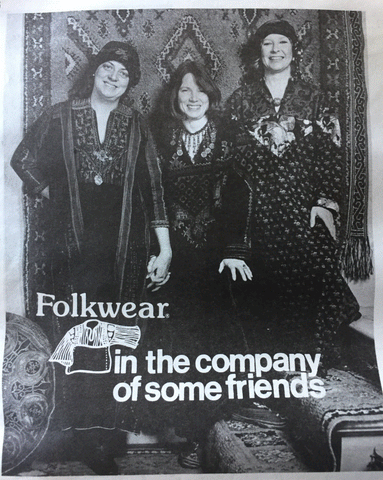- Home
- About
-
Shop
-
Sewing Patterns
-
Fabric
- Sewing Supplies
- Folkwear Clothing
-
- Blog
- Customer Gallery
- Contact
March 10, 2017 16 Comments on The History of Folkwear

The History of Folkwear
In the mid-1970s, three

The three founders were a perfect team to create a line of innovative patterns that was revolutionary for its time—this was the mid 1970s when women's wear in
During the recession of the mid-1980s, Folkwear's business health suffered along with so many other small businesses. The company was sold to The Taunton Press, publisher of Threads magazine, and by the early 1990s most of the original patterns were back in print and new patterns were under development.
In 1998,

So many different types of people use Folkwear patterns. There are historic re-enactors, Renaissance Faire participants, theater costume designers, and lovers of creative art-to-wear. Residents of historic neighborhoods and members of antique auto clubs use the patterns to dress to the appropriate historic period for their annual events. Folks who adopt children from other countries use the patterns to teach the little ones about their native cultures. Swing, tango, and ballroom dancers love to use the patterns for their passion. Living history museums and Universal Studios dress their staff in Folkwear patterns. The The male actors in the first television episode of The Lonesome Dove all wore a Folkwear pattern (#204
In 2002, Mathews purchased the Folkwear pattern division. Folkwear became, yet again, an independent, woman-owned firm, just like it was in its earliest days. Mathews ran Folkwear for 14 years, adding many new patterns to the collection. Folkwear was sold in late 2016 to Molly Hamilton, a young woman and fellow sewer, in Asheville who currently owns and runs the company. Through it all, the company has retained a loyal group of fans who keep the passion for vintage and ethnic garments alive! And, Gretchen Schields has continued to illustrate nearly all of the patterns since the inception of the company until 2017, contributing to the iconic images associated with Folkwear patterns.
-- written by Kate Mathews - fiber artist, sewer, weaver, and former owner of Folkwear
February 14, 2023
My mom was a skilled seamstress who was always trying new things. Starting in the 1970’s, Folkwear patterns would regularly enter her repertoire. Nearly 20 years after her death, a trip to Japan sparked my interest in kimono. My first thought when I decided to try making one was , “I wonder if that company is still around?” With several kimono – all using repurposed fabric – finished and gifted, I am now ordering some new patterns. Thanks for helping me keep the family tradition going.
April 21, 2022
I just love the diversity of these patterns and the fact that your models are so diverse in body types as well as ethnicities and general looks. It really embodies how your patterns are so suitable for a wide range of tastes and bodies.
March 05, 2022
I first started making Folkwear patterns in 1976 when my husband and I moved to our farm where we started our sheep and wool business. I bought a sewing machine with money my Nana left me when she passed away that year. I’ve made so many of your patterns in the last 40+ years…. Some for me and lots for my husband, and my children, and now I’m making them for my little grand girl. I love everything about Folkwear and every time I see Molly Hamilton I smile. Thank you for keeping alive the history of clothing! Beautiful…
January 28, 2022
I have been a fan of Folkwear patterns for so long. Thank you, Molly, for keeping these beautiful patterns in print and available to so many of us who love history, other cultures beauty, and of course, sewing.
November 07, 2021
My mother taught me to sew before I learned how to read or write. When I was young I was so attracted to Folkwear’s vintage patterns but now in my 50s it the global patterns I love. Just ordered the Ao Dai and I appreciate the video showing the closure. With arthritis I’m a bit past pulling garments over my head.
October 21, 2021
I have been coveting the Armistice Blouse pattern since the 1980’s when I was a broke grad student. I finally broke down and ordered it tonight! So glad that Folkwear is still here for us!
Cheers and happy stitching!
Edith Folta
Las Cruces, NM
April 04, 2020
Just here to say that since I was little, and started sewing (age 7) I’ve always loved Folkwear patterns. I will be 48 this summer and I am currently making the Gaza dress. Making it larger, of course! But East to do as the lines and such are very simple. I love Folkwear!!! Thank you for still publishing the pattern threw out my 41 year sewing journey/life❤️❤️❤️
April 04, 2020
Just here to say that since I was little, and started sewing (age 7) I’ve always loved Folkwear patterns. I will be 48 this summer and I am currently making the Gaza dress. Making it larger, of course! But East to do as the lines and such are very simple. I love Folkwear!!! Thank you for still publishing the pattern threw out my 41 year sewing journey/life❤️❤️❤️
January 11, 2020
I’m so glad to see your patterns are available again, and in a wider size range. I made a Victorian Walking Skirt (and others) decades ago, and look forward to making another one.

Suzanne
June 16, 2023
Lovely to know this company’s history, cut out and laid the pieces today for the Gibson blouse, just lovely!!!